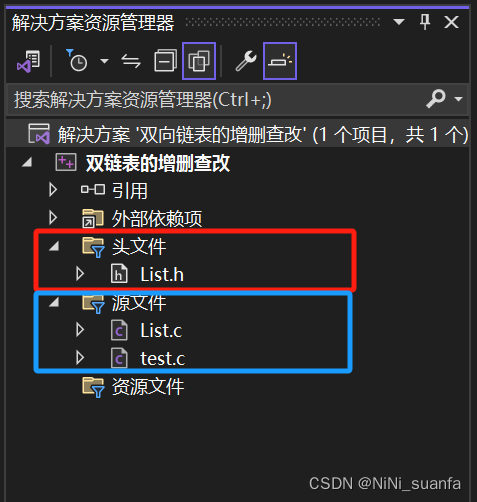文章目录
前言
引入双向链表:关于单链表的问题与讨论
单链表存在的毛病:
- 因为单链表只能单向遍历链表,
- 对于前插这个操作,单链表必须得找到所需前插节点位置的前一个,那么这时就得从头指针重新遍历一次链表,会造成时间复杂度大大增加。
- 没有头节点(哨兵位)无法删除首节点
这些都大大提高了时间复杂度 [ 关于算法的时间复杂度与空间复杂度 这一专题,我在之前写的一篇专题中有详细的讲解,有需要的可以点击链接了解一下 算法的时间复杂度与空间复杂度 ]
【注意:不要下意识觉得链表就一定有哨兵位,可以有,也可以没有!】
正是因为单链表只能 单向遍历 这一特性所带来各种的麻烦,前人设计出了双向链表。
一、双向链表的特性简概
- 特性:1. 双向2. 循环
正是因为有这两个特性,促成了双向链表很多优势:
- 不需要像单链表那样从 头节点****完整遍历一边链表,才能找到尾节点。 双向链表:直接 phead->prev 找到尾节点(双向、循环 的特性)。
- 且找到需要处理的节点,还需要从头节点再遍历一次链表,只为找到该节点的前一个节点,才能对该节点进行处理。 双向链表:pos->prev****前一节点
双向链表 逻辑样例图
代码实现
//类型声明 typedefint LTDataType;//数据类型重命名typedefstructListNode//结构体类型声明{//两头的指针变量 储存双向两旁结构体的地址structListNode* prev;//保存前一个节点的指针
LTDataType data;structListNode* next;//保存后一个节点的指针}ListNode;
二、双链表的增删查改【C 代码实现】
(一)创建文件
- List.h (双向链表双向链表的类型定义、接口函数声明、引用的头文件)
- List.c (双向链表接口函数的实现)
- test.c (主函数、测试顺序表各个接口功能)

(二)List.h
1. 头文件声明
#pragmaonce //防止头文件重复包含//头文件#include<stdio.h>#include<stdlib.h>#include<assert.h>
2. 双向结构体类型声明
//类型声明 typedefint LTDataType;//数据类型重命名typedefstructListNode//结构体类型声明{structListNode* prev;//两头的指针变量 储存双向两旁结构体的地址
LTDataType data;structListNode* next;}ListNode;
(三)List.c
1.创建返回双向链表的头结点.
图解
phead 的含义 = pointer to head
// 创建返回链表的头结点.
ListNode*ListCreate(){
ListNode* phead =(ListNode*)malloc(sizeof(ListNode));//结构体指针phead 存的是malloc为新结构体开辟内存后 的返回的该新节点的指针 assert(malloc);return phead;//phead传的是phead指针的内容=head地址 =>返回结构体地址 }
2. 双向链表的初始化
// 双向链表的初始化voidListInit(ListNode* phead){//也用phead接受传过来的head的地址assert(phead);
phead->prev = phead->next;
phead->data =0;//加深对指针的理解
phead->next = phead->prev;//直接用head【记住:1. **名 直接用的是内容** 明白这点 对于指针的理解就轻松很多】//2. -> 只能对指针使用 且不支持二级指针解引用*后得到一级指针的形式// (如:ListNode** pphead **pphead->data (x)好像不行 去试一下 )
【关于指针注意的点的讲解】
}
【关于指针注意的点的讲解】 :加深对指针的理解
- 直接用head => 名 直接用的是内容 明白这点 对于指针的理解就轻松很多
- -> 只能对指针使用 且不支持二级指针解引用后得到一级指针的形式 (如:ListNode* pphead **pphead->data (x) 好像不行 去试一下 )
3.创建返回新节点
// 创建返回新节点
ListNode*BuynewNode(x){
ListNode* newNode =(ListNode*)malloc(sizeof(ListNode));
newNode->data = x;return newNode;}
4.双向链表尾插
// 双向链表尾插voidListPushBack(ListNode* phead,LTDataType x){
ListNode* newNode =BuynewNode(x);//1M的空间可创建出一千多万个指针变量
ListNode* tail = phead->prev;//多创建指针变量 自己也标的看的清楚 增加代码的可读性
tail->next = newNode;
newNode->prev = tail;
newNode->next = phead;
phead->prev = newNode;}
5.双向链表头插
// 双向链表头插voidListPushFront(ListNode* phead, LTDataType x){
ListNode* newNode =BuynewNode(x);
ListNode* first = phead->next;//第一个节点
newNode->next = first;
first->prev = newNode;
phead->next = newNode;
newNode->prev = phead;}
6.双向链表尾删
// 双向链表尾删voidListPopBack(ListNode* phead){assert(phead);assert(phead->next != phead);//确保链表不为空,有东西可删,及时报错
ListNode* tailPrev = phead->prev->prev;
ListNode* tail = phead->prev;free(tail);
tail =NULL;
tailPrev->next = phead;
phead->prev = tailPrev;}
7.双向链表头删
// 双向链表头删voidListPopFront(ListNode* phead){assert(phead);assert(phead->next != phead);
ListNode* newNext = phead->next->next;
ListNode* Next = phead->next;//新建指针变量 保存好要free掉的节点的地址free(Next);//就不用怕后续改变各节点之间的指针关系时把该节点的地址弄丢了
Next =NULL;
phead->next = newNext;
newNext->prev = phead;}
8.双向链表查找
// 双向链表查找
ListNode*ListFind(ListNode* phead, LTDataType x){
ListNode* Head = phead->next;//设置两个指针变量,一个从头开始遍历,一个从后遍历
ListNode* Back = phead->prev;while(Head!=Back){if(Head->data = x)return Head;elseif(Back->data = x)return Back;
Head = Head->next;
Back = Back->prev;}returnNULL;}
9.双向链表在pos的前面进行插入
// 双向链表在pos的前面进行插入voidListInsert(ListNode* pos, LTDataType x){
ListNode* posPrev = pos->prev;
ListNode* newNode =BuynewNode(x);
posPrev->next = newNode;
newNode->prev = posPrev;
newNode->next = pos;
pos->prev = newNode;}
★10. 双向链表删除pos位置的节点
// 双向链表删除pos位置的节点 //若传过来的pos=phead->next =>作头删作用voidListErase(ListNode* pos){
ListNode* posPrev = pos->prev;//若传过来的pos=phead(由于双向链表具有循环的特性) =>作尾删作用
ListNode* posNext = pos->next;//也正是由于双向链表具有循环的特性,即使链表中只有一个节点也能很好的运行
posPrev->next = posNext;//图解
posNext->prev = posPrev;free(pos);
pos =NULL;}
Erase函数以后 头删和尾删也可以这样写
10.1 双向链表尾删【ListErase版本】
voidListPopBack(ListNode* phead){assert(phead);assert(phead->next != phead);//确保链表不为空,有东西可删,及时报错ListErase(phead);}
10.2 双向链表头删【ListErase版本】
// 双向链表头删【ListErase版本】voidListPopFront(ListNode* phead){assert(phead);assert(phead->next != phead);//确保链表不为空,有东西可删,及时报错ListErase(phead->next);}
11.双向链表打印
11.1 递归实现
// 双向链表打印 递归实现voidListPrint(ListNode* phead){assert(phead);
ListNode* cur = phead->next;while(cur!=phead){printf("%d <=>", cur->data);
cur = cur->next;ListPrint(cur);}printf("\n");}
11.2 非递归实现
// 双向链表打印 非递归实现voidListPrint(ListNode* phead){assert(phead);
ListNode* cur = phead->next;while(cur!=phead){
cur = phead->next;printf("%d <=>", cur->data);}}
12. 双向链表销毁
// 双向链表销毁voidListDestory(ListNode* phead){
ListNode* cur = phead->next;while(cur!=phead){
ListNode* curNext = cur->next;free(cur);
cur = curNext;}free(phead);
phead =NULL;}
三、完整代码
码源 我已上传至gitee 有需要的可点击后方链接 双向链表的增删查改 码源
1.List.h
#pragmaonce //防止头文件重复包含#include<stdio.h>//头文件#include<stdlib.h>#include<assert.h>// 带头+双向+循环链表增删查改实现//类型声明 typedefint LTDataType;//数据类型重命名typedefstructListNode//结构体类型声明{structListNode* prev;//两头的指针变量 储存双向两旁结构体的地址
LTDataType data;structListNode* next;}ListNode;// 创建返回双向链表的头结点.
ListNode*ListCreate();// 双向链表的初始化voidListInit(ListNode* phead);// 创建返回新节点
ListNode*BuynewNode(LTDataType x);// 双向链表尾插voidListPushBack(ListNode* phead, LTDataType x);// 双向链表头插voidListPushFront(ListNode* phead, LTDataType x);// 双向链表尾删voidListPopBack(ListNode* phead);// 双向链表头删voidListPopFront(ListNode* phead);// 双向链表查找
ListNode*ListFind(ListNode* phead, LTDataType x);// 双向链表在pos的前面进行插入voidListInsert(ListNode* pos, LTDataType x);// 双向链表删除pos位置的节点voidListErase(ListNode* pos);// 双向链表打印voidListPrint(ListNode* phead);// 双向链表销毁voidListDestory(ListNode* phead);
2.List.c
#define_CRT_SECURE_NO_WARNINGS1#include"List.h"// 创建返回链表的头结点.
ListNode*ListCreate(){
ListNode* phead =(ListNode*)malloc(sizeof(ListNode));//结构体指针phead 存的是malloc为新结构体开辟内存后 的返回的该新节点的指针 assert(malloc);return phead;//phead传的是phead指针的内容=head地址 =>返回结构体地址 }// 双向链表的初始化voidListInit(ListNode* phead){//也用phead接受传过来的head的地址assert(phead);
phead->prev = phead->next;
phead->data =0;//加深对指针的理解
phead->next = phead->prev;//直接用head【记住:1. 名 直接用的是内容 明白这点 对于指针的理解就轻松很多】//2. -> 只能对指针使用 且不支持二级指针解引用*后得到一级指针的形式// (如:ListNode** pphead **pphead->data (x)好像不行 去试一下 ) 【关于指针注意的点的讲解】}// 创建返回新节点
ListNode*BuynewNode(x){
ListNode* newNode =(ListNode*)malloc(sizeof(ListNode));
newNode->data = x;return newNode;}// 双向链表尾插voidListPushBack(ListNode* phead,LTDataType x){
ListNode* newNode =BuynewNode(x);//1M的空间可创建出一千多万个指针变量
ListNode* tail = phead->prev;//多创建指针变量 自己也标的看的清楚 增加代码的可读性
tail->next = newNode;
newNode->prev = tail;
newNode->next = phead;
phead->prev = newNode;}// 双向链表头插voidListPushFront(ListNode* phead, LTDataType x){
ListNode* newNode =BuynewNode(x);
ListNode* first = phead->next;//第一个节点
newNode->next = first;
first->prev = newNode;
phead->next = newNode;
newNode->prev = phead;}// 双向链表尾删voidListPopBack(ListNode* phead){assert(phead);assert(phead->next != phead);//确保链表不为空,有东西可删,及时报错
ListNode* tailPrev = phead->prev->prev;
ListNode* tail = phead->prev;free(tail);
tail =NULL;
tailPrev->next = phead;
phead->prev = tailPrev;}// 双向链表头删voidListPopFront(ListNode* phead){assert(phead);assert(phead->next != phead);
ListNode* newNext = phead->next->next;
ListNode* Next = phead->next;//新建指针变量 保存好要free掉的节点的地址free(Next);//就不用怕后续改变各节点之间的指针关系时把该节点的地址弄丢了
Next =NULL;
phead->next = newNext;
newNext->prev = phead;}// 双向链表查找
ListNode*ListFind(ListNode* phead, LTDataType x){
ListNode* Head = phead->next;//设置两个指针变量,一个从头开始遍历,一个从后遍历
ListNode* Back = phead->prev;while(Head!=Back){if(Head->data = x)return Head;elseif(Back->data = x)return Back;
Head = Head->next;
Back = Back->prev;}returnNULL;}// 双向链表在pos的前面进行插入voidListInsert(ListNode* pos, LTDataType x){
ListNode* posPrev = pos->prev;
ListNode* newNode =BuynewNode(x);
posPrev->next = newNode;
newNode->prev = posPrev;
newNode->next = pos;
pos->prev = newNode;}// 双向链表删除pos位置的节点 //若传过来的pos=phead->next =>作头删作用voidListErase(ListNode* pos){
ListNode* posPrev = pos->prev;//若传过来的pos=phead(由于双向链表具有循环的特性) =>作尾删作用
ListNode* posNext = pos->next;//也正是由于双向链表具有循环的特性,即使链表中只有一个节点也能很好的运行
posPrev->next = posNext;//图解
posNext->prev = posPrev;free(pos);
pos =NULL;}//Erase函数以后 头删和尾删也可以这样写// 双向链表尾删【ListErase版本】voidListPopBack(ListNode* phead){//assert(phead);//assert(phead->next != phead);//ListNode* tailPrev = phead->prev->prev;//ListNode* tail = phead->prev;//free(tail);//tail = NULL;//tailPrev->next = phead;//phead->prev = tailPrev;assert(phead);assert(phead->next != phead);//确保链表不为空,有东西可删,及时报错ListErase(phead);}// 双向链表头删【ListErase版本】voidListPopFront(ListNode* phead){//assert(phead);//assert(phead->next != phead);//ListNode* newNext = phead->next->next;//ListNode* Next = phead->next;//free(Next); //Next = NULL;//phead->next = newNext;//newNext->prev = phead;assert(phead);assert(phead->next != phead);//确保链表不为空,有东西可删,及时报错ListErase(phead->next);}// 双向链表打印 递归实现voidListPrint(ListNode* phead){assert(phead);
ListNode* cur = phead->next;while(cur!=phead){printf("%d <=>", cur->data);
cur = cur->next;ListPrint(cur);}printf("\n");}// 双向链表打印 非递归实现voidListPrint(ListNode* phead){assert(phead);
ListNode* cur = phead->next;while(cur!=phead){
cur = phead->next;printf("%d <=>", cur->data);}}// 双向链表销毁voidListDestory(ListNode* phead){
ListNode* cur = phead->next;while(cur!=phead){
ListNode* curNext = cur->next;free(cur);
cur = curNext;}free(phead);
phead =NULL;}
3.test.c
#define_CRT_SECURE_NO_WARNINGS1#include"List.h"//测试ListPushBack 、ListPrint 的功能voidtest1(){
ListNode* phead =ListCreate();//返回head的地址ListInit(phead);ListPushBack(phead,1);//测试ListPushBackListPushBack(phead,2);ListPushBack(phead,3);ListPrint(phead);//测试ListPrint}voidtest2(){
ListNode* phead =ListCreate();//返回head的地址ListInit(phead);ListPushBack(phead,1);ListPushBack(phead,2);ListPushBack(phead,3);ListPushBack(phead,4);ListPushBack(phead,5);ListPushBack(phead,6);ListPrint(phead);
ListNode* pos =ListFind(phead,3);//测试ListFindListErase(pos);//测试ListEraseListPopFront(phead);//测试ListPopFrontListPopBack(phead);//测试ListPopBackListPrint(phead);
pos =ListFind(phead,2);ListInsert(pos,8);ListPrint(phead);}//测试ListDestoryvoidtest3(){
ListNode* phead =ListCreate();//返回head的地址ListInit(phead);ListPushBack(phead,1);ListPushBack(phead,2);ListPushBack(phead,3);ListPushBack(phead,4);ListPushBack(phead,5);ListPushBack(phead,6);ListPrint(phead);
ListNode* pos =ListFind(phead,3);ListErase(pos);ListPopFront(phead);ListPopBack(phead);ListPrint(phead);
pos =ListFind(phead,2);ListInsert(pos,8);ListPrint(phead);ListDestory(phead);}intmain(){test1();//测试ListPushBack 、ListPrinttest2();//测试test3();//测试ListDestory}```
版权归原作者 NiNi_suanfa 所有, 如有侵权,请联系我们删除。